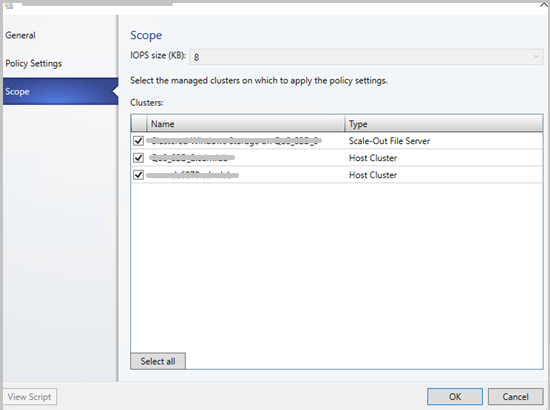Manage storage QoS for clusters
This article describes how to manage storage quality-of-service (QoS) policies for clusters in System Center Virtual Machine Manager (VMM).
Assign storage QoS policy for clusters
Windows server 2016 and later allows the deployments to use the storage QoS feature with any VHDs residing on a Cluster Shared Volume (CSV). In VMM 2016, the management of SQoS is limited to VHDs residing on the S2D hyper-converged type clusters and Scale-Out File Servers only (SOFS). Also, the scope of QoS policies is based on the storage arrays, which isn't scalable to the scenarios like SAN, where VMM only manages the compute cluster.
VMM supports QoS on all managed clusters and also SOFS running on Windows Server 2016 and later.
Note
VMM 2019 UR3 and later supports Azure Stack Hyper Converged Infrastructure (HCI, version 20H2).
Assign storage QoS policy for clusters
Windows server 2019 and later allows the deployments to use the storage QoS feature with any VHDs residing on a Cluster Shared Volume (CSV). In VMM 2025, the management of SQoS is limited to VHDs residing on the S2D hyper-converged type clusters and Scale-Out File Servers only (SOFS). Also, the scope of QoS policies is based on the storage arrays, which isn't scalable to the scenarios like SAN, where VMM only manages the compute cluster.
VMM 2025 supports QoS on all managed clusters and also SOFS running on Windows Server 2019 and later.
Note
VMM 2025 supports Azure Local (version 23H2 and 22H2).
Use these steps:
Select Fabric > Storage > QoS Policies > Create Storage QoS Policy.
In the wizard > General, specify a policy name.
In Policy Settings, specify how the policy must apply. Select All virtual disk instances share resources to specify that the policy must be applied to all virtual disks on the file server (pooled, single instance). Select Resources allocated to each virtual disk instance to specify that the policy is applied separately to each specified virtual disk (multi-instance). Specify the minimum and maximum IOPS. A setting of 0 means that no policy is enforced.
In Scope, select the managed cluster under Clusters to which you want to apply the policy.

In Summary, verify the settings and finish the wizard.
On Upgrade
After upgrade, existing deployments that are managing their QoS with VMM can seamlessly migrate to the new QoS scoping based on the cluster name.
PowerShell cmdlets
The following new parameters are added:
| Affected cmdlet | Parameter | Details |
|---|---|---|
| New-SCStorageQoSPolicy | -HostCluster | Specifies an array of HostCluster objects for QoS policy scope. Optional. |
| New-SCVIrtualDiskDrive | -StorageQoSPolicy | Allows you to select the storage QoS policy for the Virtual Disk Drive. Optional. |
| Set-SCStorageQoSPolicy | -HostCluster | Specifies an array of HostCluster objects to be added in the QoS policy scope. Optional. |
| Get-SCStorageQoSPolicy | -HostCluster | Specifies a HostCluster object for which we want to query the QoS policies. Optional. |
Assign a storage QoS Policy from templates
Templates usage is a common way for deploying VMs and Services on a cloud.
You can select storage QoS policies from a template as well. For information on how to assign storage QoS policies from templates, see the related procedure in the create a VM template article.